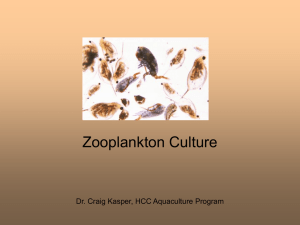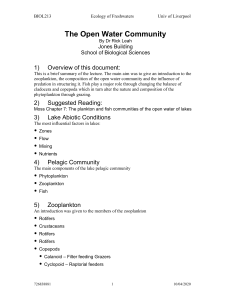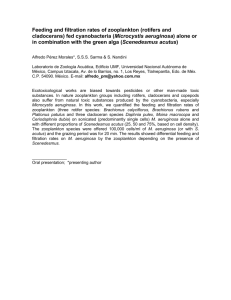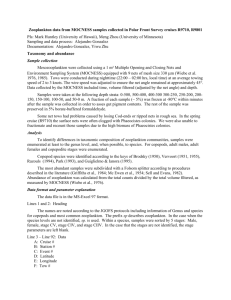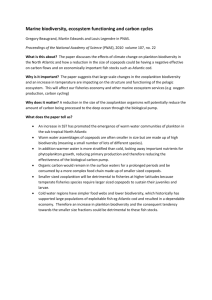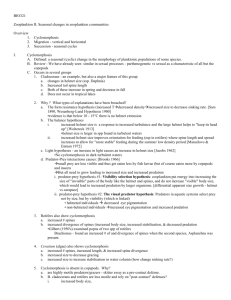Animals
advertisement
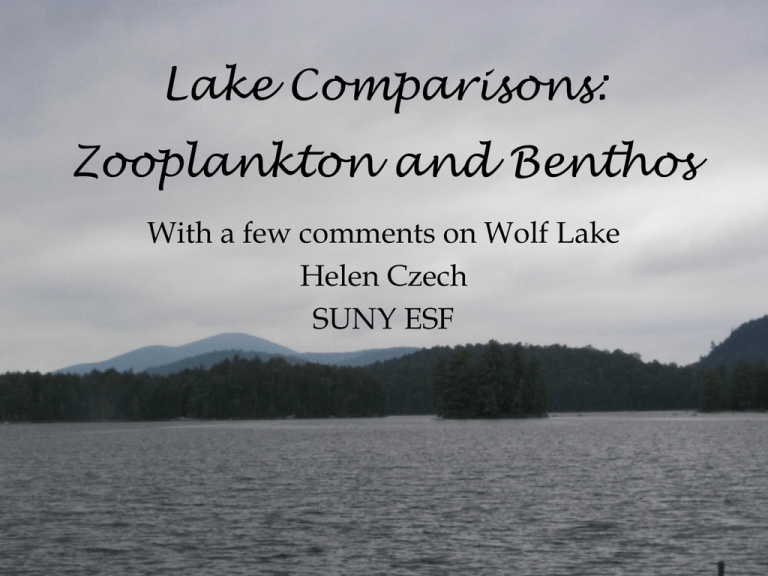
Lake Comparisons: Zooplankton and Benthos With a few comments on Wolf Lake Helen Czech SUNY ESF Zooplankton: Why are we interested? • Zooplankton are important indicators of aquatic systems • They can indicate predator-prey relationships • They effect phytoplankton and zoo populations are driven in turn by predatory inverts and fish • Rotifers are not well studied Zooplankton Collection Methods • A Schindler trap was used to collect samples. • One sample per layer (epi, meta and hypo) was collected / lake (except for Green Lake, which had 2 / layer including a chemo layer). • Collected samples were washed into a collection bottle and then treated with Alka seltzer and eventually ethanol. • 2 whole lake net tows were taken from bottom to top »http://aslo.org/photopost/showphoto.php?photo=196 In Lab Analysis of Preserved Zooplankton • Zooplankton samples were counted in lab using a dissecting microscope and a tray. • 100 of the most common species (typically 3 -5) per layer Wolf Lake www.fieldmuseum.org/.../images/wolflake_lg.jpg Wolf Meta Wolf Hypo 14 14 12 12 12 10 10 10 cladocerans 8 copepods rotifers 6 protzoan 8 cladocerans copepods 6 rotifers Individuals/L 14 Individuals/L Individuals/L Wolf Epi 8 copepods 4 4 4 2 2 2 0 0 rotifers 0 Zooplankton Types Zooplankton Types cladocerans 6 Zooplankton Types •Meta has greatest number of major groups •Rotifers are most abundant, followed by copepods www.ksu.edu •Common in samples were Calaniod and Cyclopoid copepods and nauplii www.stetson.edu •Observed rotifers: Keratella, Kellicotia and Polyarthra •One protozoan, Difflugia www.stetson.edu 192.171.163.165 www.serc.si.edu faculty-staff.ou.edu Onondaga Lake Onondaga Epi Onondaga Meta 600 600 500 500 500 400 300 Copepods 400 Cladocerans 300 Copepods Individuals/L Cladocerans Individuals/L 400 Individuals/L Onondaga Hypo 600 200 200 200 100 100 100 0 0 Zooplankton Groups Cladocerans 300 Copepods 0 Zooplankton Types Zooplankton Types •The epi had the greatest number of individuals •Cladocerans were the most common, followed by copepods www.yale.edu •Bosmina was most common, followed by Daphnia and Cyclopoid copepods •The invasive Cercopagis was observed www.dnr.cornell.edu www.nysm.nysed.gov Arbutus Lake www.efloras.org Arbutus Hypo 60 50 Inds/L 40 copepods cladocerans 30 rotifers dipterans 20 10 0 Zooplankton Types •Copepods were the most common, and all zooplankton were more common in the epi layer. •Chaoborus was the dipteran www.microscopy-uk.org.uk Catlin Lake Catlin Epi Catlin Hypo 12 12 12 10 10 10 8 Copepods 6 Rotifers Dipterans 4 2 8 Copepods Ind/L Cladocerans 6 Cladocerans Rotifers 4 Rotifers 2 0 Zooplankton Types Cladocerans 6 4 2 0 Copepods Inds/L 8 Ind/L Catlin Meta Zooplankton Types 0 Zooplankton Types •Again, copepods and rotifers were the most common. •Numbers were not large, few in the samples www.gobacktothebasics.com Oneida Lake www.esf.edu/.../gallery/oneida/xingye3small.jpg • Data not available for analysis • Zooplankton observed are listed in Table 1 • The meta layer appears to have the greatest diversity www.microscope-microscope.org cfb.unh.edu Zooplankton Epi Meta Hypo Cyclopoids X X X Calanoids X X X X X X X Nauplius Bosmina X Daphnia X Diaphanasoma X X Polyarthra X X X X Keratella X Hydra X Table 1. Zooplankton in Oneida Lake Green Lake •The hypo layer had the greatest number of cladocerans and copepods •Calanoids were the most common. •The chemo and mono layer had very few zooplankton Lake Comparison • The Adirondack lakes have good diversity, but few zoo in samples. Copepods were common, as were rotifers • Onondaga Lake had a lot of zoo in comparison to the other lakes • Green Lake also had low numbers • Oneida had some diversity. • Typically the epi or meta had the greatest # And let’s not forget benthos! Benthos are defined the organisms found inhabiting the bottoms of lakes, rivers and streams, and are often important indicators of health and diversity, pollution Common benthic organisms include molluscs, aquatic insects, oligochaetes Benthos collection • Benthos were collected with an Eckman Dredge • Sample were seived and inverts were preserved in ethanol www.cee.vt.edu Benthos we Found • Catlin Lake - Molannidae caddisfly, Chaoborus midge • Arbutus Lake: No data • Wolf Lake- Molannidae caddisfly, Chaoborus midge, Unionid mussel, Chironimidae • Onondaga Lake – YUCK – no benthos taken • Oneida Lake – Chironimidae, gastropoda, Zebra Mussel • Green Lake – we collected, but there was nothing in the sample. Problems • Errors in data collection could be from improperly washing out the Schindler. • Human error in counting or improper mixing. Wolf Lake • Very pristine lake • High diversity in zoo, but low numbers • Phyto numbers very low, which could explain low zoo numbers • Not a lot of silica, and not a lot of diatoms in the samples • pH is average, not too low • Seems to be oligotrophic, not a lot of N • Turbidity is low • DO was fairly high

